Strategic Analysis and Recommendations for Lidl Malta's Future Growth
VerifiedAdded on 2023/01/12
|17
|5456
|28
Report
AI Summary
This report presents a strategic analysis of Lidl Malta, a retail brand operating in Malta. It begins with an introduction outlining the scope of the analysis, followed by an examination of the external environment using PESTLE and Porter's Five Forces models to assess political, economic, social, technological, legal, and environmental factors, as well as industry competitiveness. The report then delves into Lidl Malta's internal environment, evaluating its mission, vision, and core competencies through VRIO and Business Canvas models. Finally, it discusses potential strategic options, including Porter's Generic Strategies, Bowman Clock Model, and integration strategies, to defend and enhance Lidl Malta's market position. The analysis aims to provide actionable recommendations for the company's future growth and strategic direction within the Maltese retail industry, considering both internal capabilities and external market dynamics. The report concludes with a summary of findings and recommendations, supported by references to relevant literature.
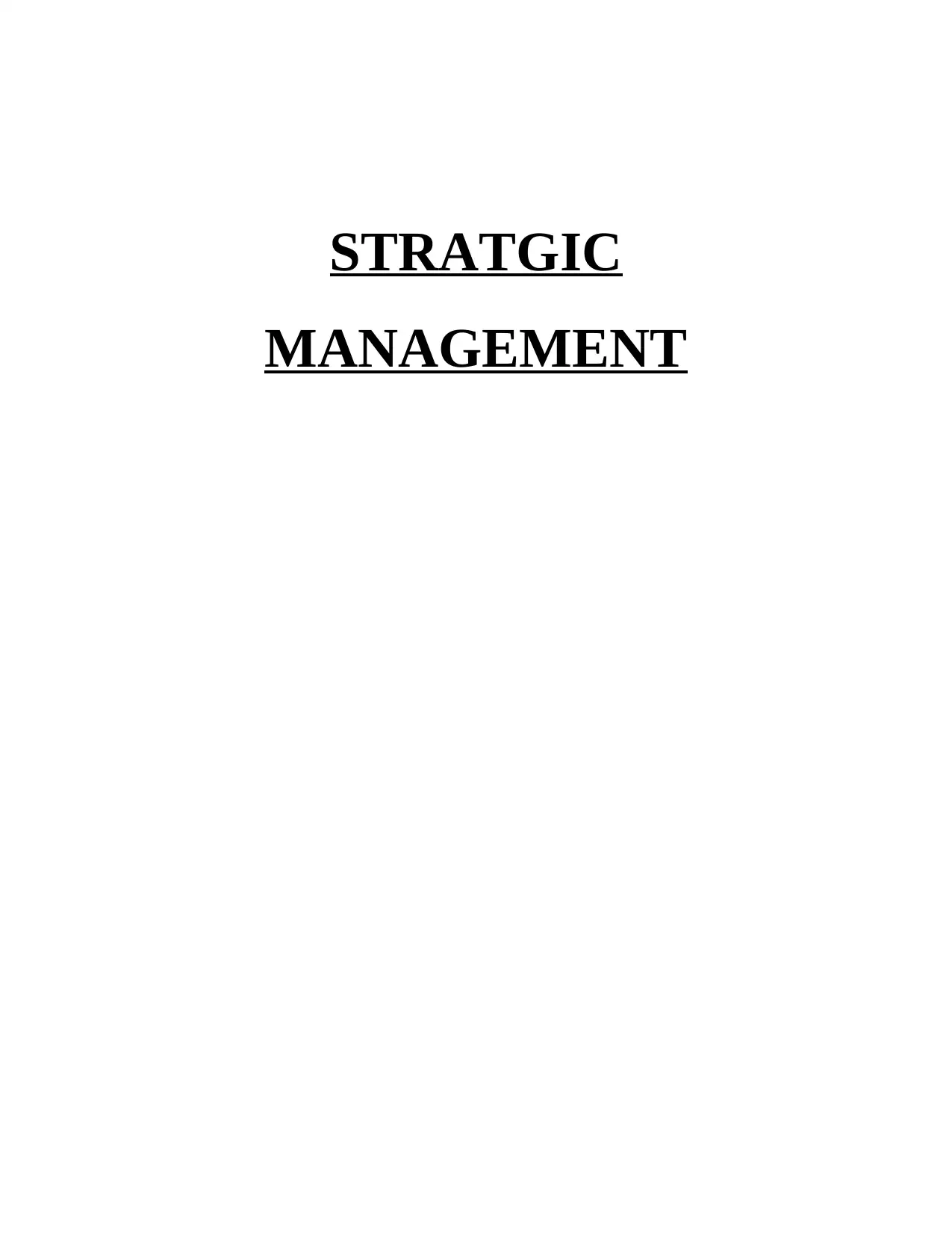
STRATGIC
MANAGEMENT
MANAGEMENT
Paraphrase This Document
Need a fresh take? Get an instant paraphrase of this document with our AI Paraphraser
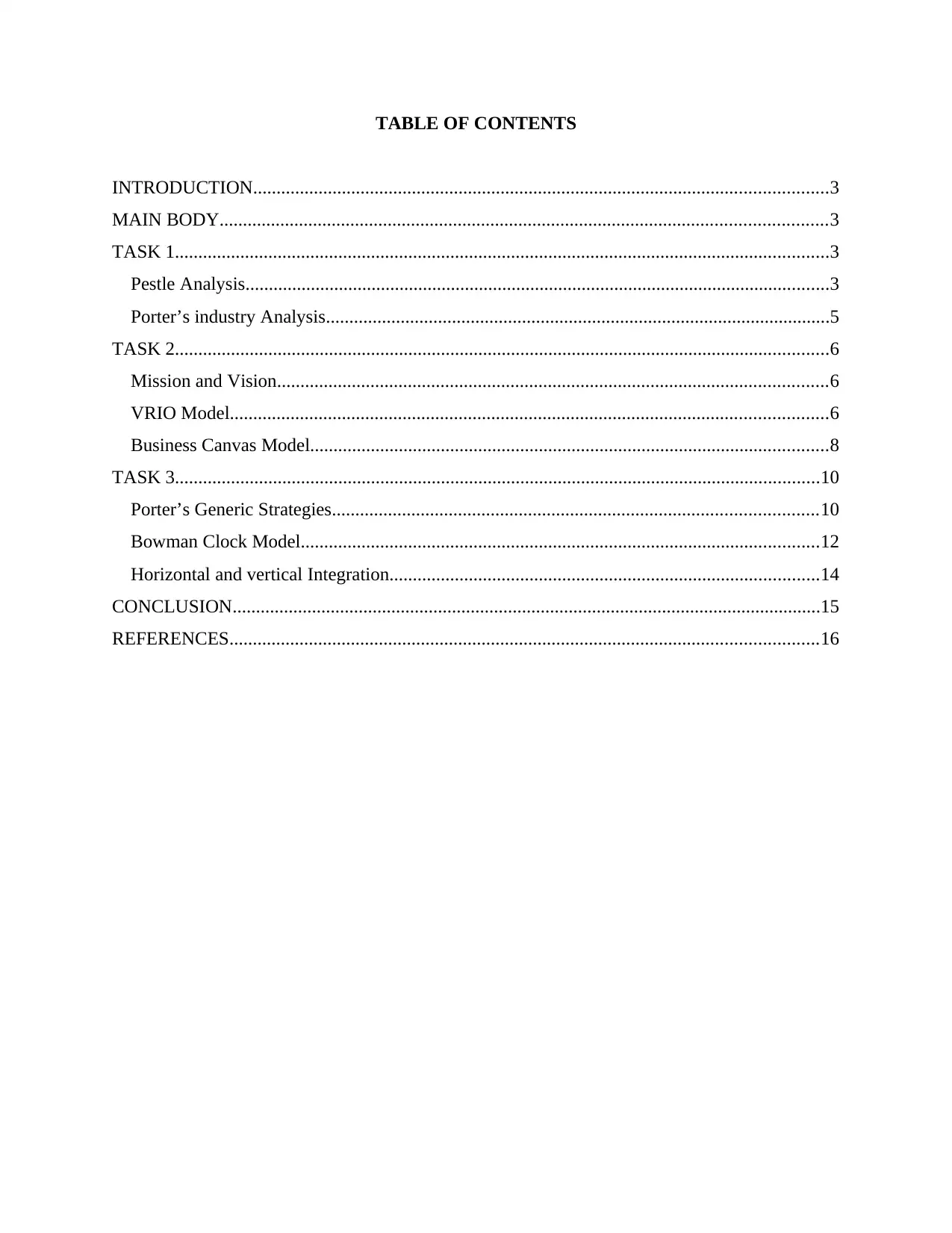
TABLE OF CONTENTS
INTRODUCTION...........................................................................................................................3
MAIN BODY..................................................................................................................................3
TASK 1............................................................................................................................................3
Pestle Analysis.............................................................................................................................3
Porter’s industry Analysis............................................................................................................5
TASK 2............................................................................................................................................6
Mission and Vision......................................................................................................................6
VRIO Model................................................................................................................................6
Business Canvas Model...............................................................................................................8
TASK 3..........................................................................................................................................10
Porter’s Generic Strategies........................................................................................................10
Bowman Clock Model...............................................................................................................12
Horizontal and vertical Integration............................................................................................14
CONCLUSION..............................................................................................................................15
REFERENCES..............................................................................................................................16
INTRODUCTION...........................................................................................................................3
MAIN BODY..................................................................................................................................3
TASK 1............................................................................................................................................3
Pestle Analysis.............................................................................................................................3
Porter’s industry Analysis............................................................................................................5
TASK 2............................................................................................................................................6
Mission and Vision......................................................................................................................6
VRIO Model................................................................................................................................6
Business Canvas Model...............................................................................................................8
TASK 3..........................................................................................................................................10
Porter’s Generic Strategies........................................................................................................10
Bowman Clock Model...............................................................................................................12
Horizontal and vertical Integration............................................................................................14
CONCLUSION..............................................................................................................................15
REFERENCES..............................................................................................................................16
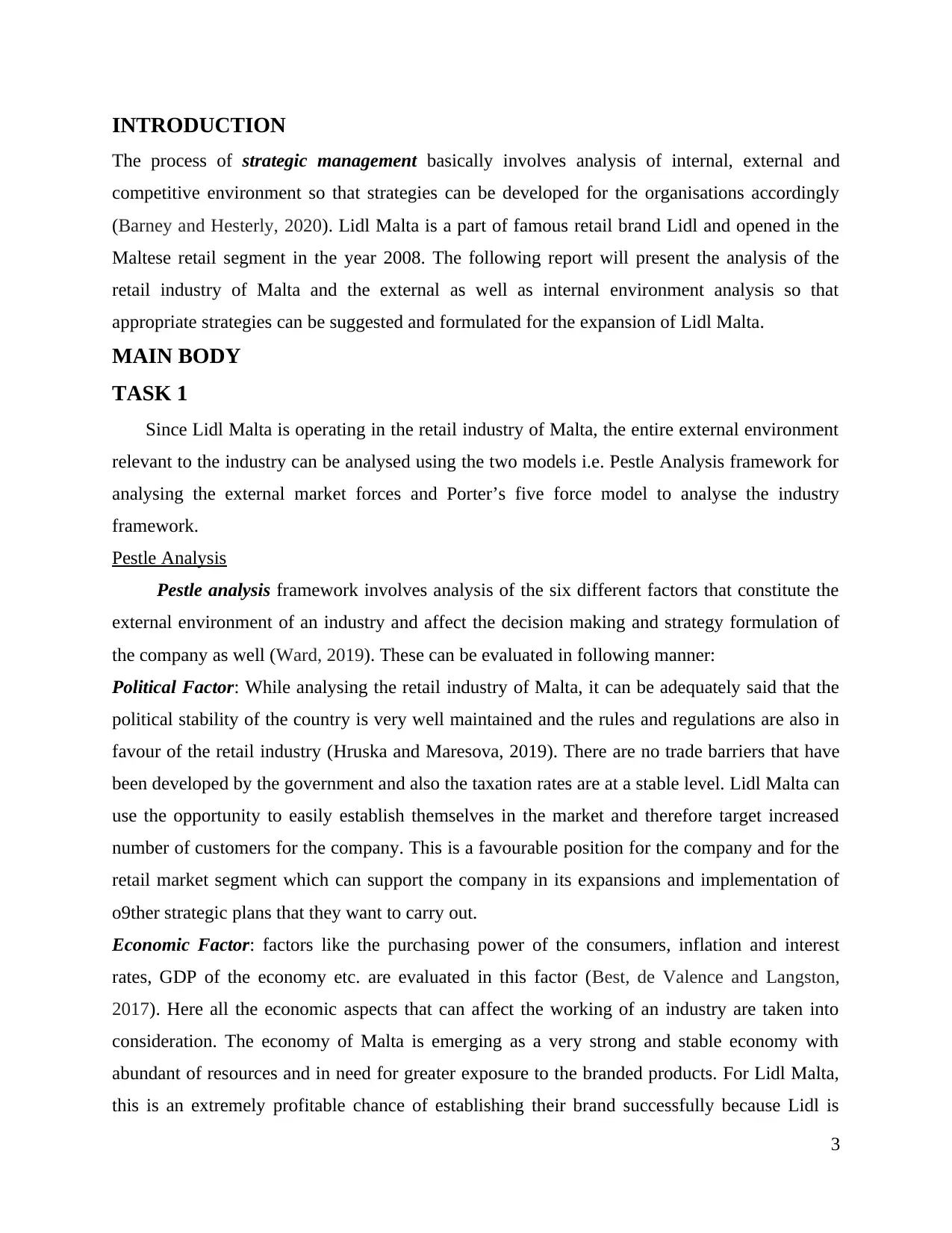
INTRODUCTION
The process of strategic management basically involves analysis of internal, external and
competitive environment so that strategies can be developed for the organisations accordingly
(Barney and Hesterly, 2020). Lidl Malta is a part of famous retail brand Lidl and opened in the
Maltese retail segment in the year 2008. The following report will present the analysis of the
retail industry of Malta and the external as well as internal environment analysis so that
appropriate strategies can be suggested and formulated for the expansion of Lidl Malta.
MAIN BODY
TASK 1
Since Lidl Malta is operating in the retail industry of Malta, the entire external environment
relevant to the industry can be analysed using the two models i.e. Pestle Analysis framework for
analysing the external market forces and Porter’s five force model to analyse the industry
framework.
Pestle Analysis
Pestle analysis framework involves analysis of the six different factors that constitute the
external environment of an industry and affect the decision making and strategy formulation of
the company as well (Ward, 2019). These can be evaluated in following manner:
Political Factor: While analysing the retail industry of Malta, it can be adequately said that the
political stability of the country is very well maintained and the rules and regulations are also in
favour of the retail industry (Hruska and Maresova, 2019). There are no trade barriers that have
been developed by the government and also the taxation rates are at a stable level. Lidl Malta can
use the opportunity to easily establish themselves in the market and therefore target increased
number of customers for the company. This is a favourable position for the company and for the
retail market segment which can support the company in its expansions and implementation of
o9ther strategic plans that they want to carry out.
Economic Factor: factors like the purchasing power of the consumers, inflation and interest
rates, GDP of the economy etc. are evaluated in this factor (Best, de Valence and Langston,
2017). Here all the economic aspects that can affect the working of an industry are taken into
consideration. The economy of Malta is emerging as a very strong and stable economy with
abundant of resources and in need for greater exposure to the branded products. For Lidl Malta,
this is an extremely profitable chance of establishing their brand successfully because Lidl is
3
The process of strategic management basically involves analysis of internal, external and
competitive environment so that strategies can be developed for the organisations accordingly
(Barney and Hesterly, 2020). Lidl Malta is a part of famous retail brand Lidl and opened in the
Maltese retail segment in the year 2008. The following report will present the analysis of the
retail industry of Malta and the external as well as internal environment analysis so that
appropriate strategies can be suggested and formulated for the expansion of Lidl Malta.
MAIN BODY
TASK 1
Since Lidl Malta is operating in the retail industry of Malta, the entire external environment
relevant to the industry can be analysed using the two models i.e. Pestle Analysis framework for
analysing the external market forces and Porter’s five force model to analyse the industry
framework.
Pestle Analysis
Pestle analysis framework involves analysis of the six different factors that constitute the
external environment of an industry and affect the decision making and strategy formulation of
the company as well (Ward, 2019). These can be evaluated in following manner:
Political Factor: While analysing the retail industry of Malta, it can be adequately said that the
political stability of the country is very well maintained and the rules and regulations are also in
favour of the retail industry (Hruska and Maresova, 2019). There are no trade barriers that have
been developed by the government and also the taxation rates are at a stable level. Lidl Malta can
use the opportunity to easily establish themselves in the market and therefore target increased
number of customers for the company. This is a favourable position for the company and for the
retail market segment which can support the company in its expansions and implementation of
o9ther strategic plans that they want to carry out.
Economic Factor: factors like the purchasing power of the consumers, inflation and interest
rates, GDP of the economy etc. are evaluated in this factor (Best, de Valence and Langston,
2017). Here all the economic aspects that can affect the working of an industry are taken into
consideration. The economy of Malta is emerging as a very strong and stable economy with
abundant of resources and in need for greater exposure to the branded products. For Lidl Malta,
this is an extremely profitable chance of establishing their brand successfully because Lidl is
3
⊘ This is a preview!⊘
Do you want full access?
Subscribe today to unlock all pages.

Trusted by 1+ million students worldwide
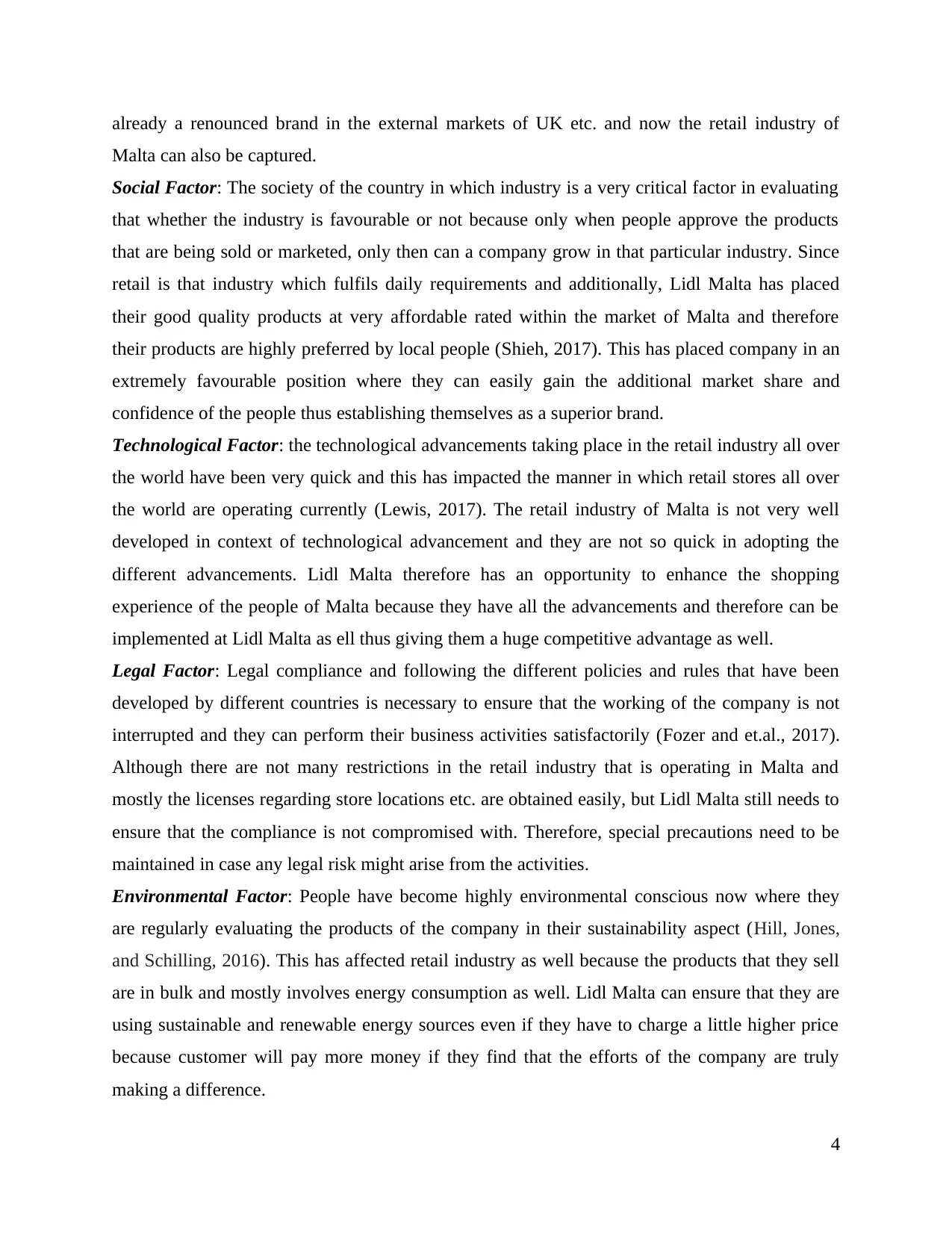
already a renounced brand in the external markets of UK etc. and now the retail industry of
Malta can also be captured.
Social Factor: The society of the country in which industry is a very critical factor in evaluating
that whether the industry is favourable or not because only when people approve the products
that are being sold or marketed, only then can a company grow in that particular industry. Since
retail is that industry which fulfils daily requirements and additionally, Lidl Malta has placed
their good quality products at very affordable rated within the market of Malta and therefore
their products are highly preferred by local people (Shieh, 2017). This has placed company in an
extremely favourable position where they can easily gain the additional market share and
confidence of the people thus establishing themselves as a superior brand.
Technological Factor: the technological advancements taking place in the retail industry all over
the world have been very quick and this has impacted the manner in which retail stores all over
the world are operating currently (Lewis, 2017). The retail industry of Malta is not very well
developed in context of technological advancement and they are not so quick in adopting the
different advancements. Lidl Malta therefore has an opportunity to enhance the shopping
experience of the people of Malta because they have all the advancements and therefore can be
implemented at Lidl Malta as ell thus giving them a huge competitive advantage as well.
Legal Factor: Legal compliance and following the different policies and rules that have been
developed by different countries is necessary to ensure that the working of the company is not
interrupted and they can perform their business activities satisfactorily (Fozer and et.al., 2017).
Although there are not many restrictions in the retail industry that is operating in Malta and
mostly the licenses regarding store locations etc. are obtained easily, but Lidl Malta still needs to
ensure that the compliance is not compromised with. Therefore, special precautions need to be
maintained in case any legal risk might arise from the activities.
Environmental Factor: People have become highly environmental conscious now where they
are regularly evaluating the products of the company in their sustainability aspect (Hill, Jones,
and Schilling, 2016). This has affected retail industry as well because the products that they sell
are in bulk and mostly involves energy consumption as well. Lidl Malta can ensure that they are
using sustainable and renewable energy sources even if they have to charge a little higher price
because customer will pay more money if they find that the efforts of the company are truly
making a difference.
4
Malta can also be captured.
Social Factor: The society of the country in which industry is a very critical factor in evaluating
that whether the industry is favourable or not because only when people approve the products
that are being sold or marketed, only then can a company grow in that particular industry. Since
retail is that industry which fulfils daily requirements and additionally, Lidl Malta has placed
their good quality products at very affordable rated within the market of Malta and therefore
their products are highly preferred by local people (Shieh, 2017). This has placed company in an
extremely favourable position where they can easily gain the additional market share and
confidence of the people thus establishing themselves as a superior brand.
Technological Factor: the technological advancements taking place in the retail industry all over
the world have been very quick and this has impacted the manner in which retail stores all over
the world are operating currently (Lewis, 2017). The retail industry of Malta is not very well
developed in context of technological advancement and they are not so quick in adopting the
different advancements. Lidl Malta therefore has an opportunity to enhance the shopping
experience of the people of Malta because they have all the advancements and therefore can be
implemented at Lidl Malta as ell thus giving them a huge competitive advantage as well.
Legal Factor: Legal compliance and following the different policies and rules that have been
developed by different countries is necessary to ensure that the working of the company is not
interrupted and they can perform their business activities satisfactorily (Fozer and et.al., 2017).
Although there are not many restrictions in the retail industry that is operating in Malta and
mostly the licenses regarding store locations etc. are obtained easily, but Lidl Malta still needs to
ensure that the compliance is not compromised with. Therefore, special precautions need to be
maintained in case any legal risk might arise from the activities.
Environmental Factor: People have become highly environmental conscious now where they
are regularly evaluating the products of the company in their sustainability aspect (Hill, Jones,
and Schilling, 2016). This has affected retail industry as well because the products that they sell
are in bulk and mostly involves energy consumption as well. Lidl Malta can ensure that they are
using sustainable and renewable energy sources even if they have to charge a little higher price
because customer will pay more money if they find that the efforts of the company are truly
making a difference.
4
Paraphrase This Document
Need a fresh take? Get an instant paraphrase of this document with our AI Paraphraser
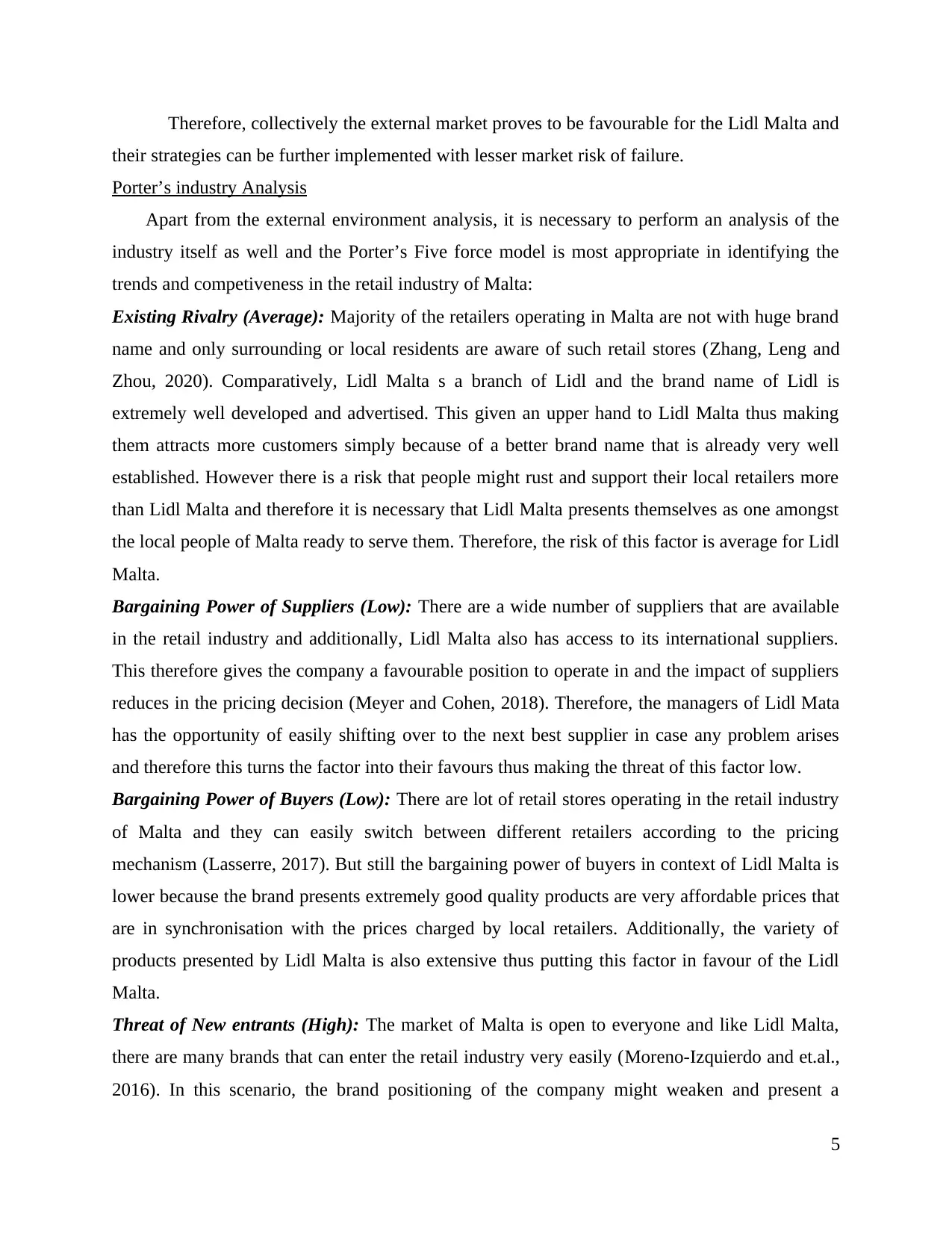
Therefore, collectively the external market proves to be favourable for the Lidl Malta and
their strategies can be further implemented with lesser market risk of failure.
Porter’s industry Analysis
Apart from the external environment analysis, it is necessary to perform an analysis of the
industry itself as well and the Porter’s Five force model is most appropriate in identifying the
trends and competiveness in the retail industry of Malta:
Existing Rivalry (Average): Majority of the retailers operating in Malta are not with huge brand
name and only surrounding or local residents are aware of such retail stores (Zhang, Leng and
Zhou, 2020). Comparatively, Lidl Malta s a branch of Lidl and the brand name of Lidl is
extremely well developed and advertised. This given an upper hand to Lidl Malta thus making
them attracts more customers simply because of a better brand name that is already very well
established. However there is a risk that people might rust and support their local retailers more
than Lidl Malta and therefore it is necessary that Lidl Malta presents themselves as one amongst
the local people of Malta ready to serve them. Therefore, the risk of this factor is average for Lidl
Malta.
Bargaining Power of Suppliers (Low): There are a wide number of suppliers that are available
in the retail industry and additionally, Lidl Malta also has access to its international suppliers.
This therefore gives the company a favourable position to operate in and the impact of suppliers
reduces in the pricing decision (Meyer and Cohen, 2018). Therefore, the managers of Lidl Mata
has the opportunity of easily shifting over to the next best supplier in case any problem arises
and therefore this turns the factor into their favours thus making the threat of this factor low.
Bargaining Power of Buyers (Low): There are lot of retail stores operating in the retail industry
of Malta and they can easily switch between different retailers according to the pricing
mechanism (Lasserre, 2017). But still the bargaining power of buyers in context of Lidl Malta is
lower because the brand presents extremely good quality products are very affordable prices that
are in synchronisation with the prices charged by local retailers. Additionally, the variety of
products presented by Lidl Malta is also extensive thus putting this factor in favour of the Lidl
Malta.
Threat of New entrants (High): The market of Malta is open to everyone and like Lidl Malta,
there are many brands that can enter the retail industry very easily (Moreno-Izquierdo and et.al.,
2016). In this scenario, the brand positioning of the company might weaken and present a
5
their strategies can be further implemented with lesser market risk of failure.
Porter’s industry Analysis
Apart from the external environment analysis, it is necessary to perform an analysis of the
industry itself as well and the Porter’s Five force model is most appropriate in identifying the
trends and competiveness in the retail industry of Malta:
Existing Rivalry (Average): Majority of the retailers operating in Malta are not with huge brand
name and only surrounding or local residents are aware of such retail stores (Zhang, Leng and
Zhou, 2020). Comparatively, Lidl Malta s a branch of Lidl and the brand name of Lidl is
extremely well developed and advertised. This given an upper hand to Lidl Malta thus making
them attracts more customers simply because of a better brand name that is already very well
established. However there is a risk that people might rust and support their local retailers more
than Lidl Malta and therefore it is necessary that Lidl Malta presents themselves as one amongst
the local people of Malta ready to serve them. Therefore, the risk of this factor is average for Lidl
Malta.
Bargaining Power of Suppliers (Low): There are a wide number of suppliers that are available
in the retail industry and additionally, Lidl Malta also has access to its international suppliers.
This therefore gives the company a favourable position to operate in and the impact of suppliers
reduces in the pricing decision (Meyer and Cohen, 2018). Therefore, the managers of Lidl Mata
has the opportunity of easily shifting over to the next best supplier in case any problem arises
and therefore this turns the factor into their favours thus making the threat of this factor low.
Bargaining Power of Buyers (Low): There are lot of retail stores operating in the retail industry
of Malta and they can easily switch between different retailers according to the pricing
mechanism (Lasserre, 2017). But still the bargaining power of buyers in context of Lidl Malta is
lower because the brand presents extremely good quality products are very affordable prices that
are in synchronisation with the prices charged by local retailers. Additionally, the variety of
products presented by Lidl Malta is also extensive thus putting this factor in favour of the Lidl
Malta.
Threat of New entrants (High): The market of Malta is open to everyone and like Lidl Malta,
there are many brands that can enter the retail industry very easily (Moreno-Izquierdo and et.al.,
2016). In this scenario, the brand positioning of the company might weaken and present a
5
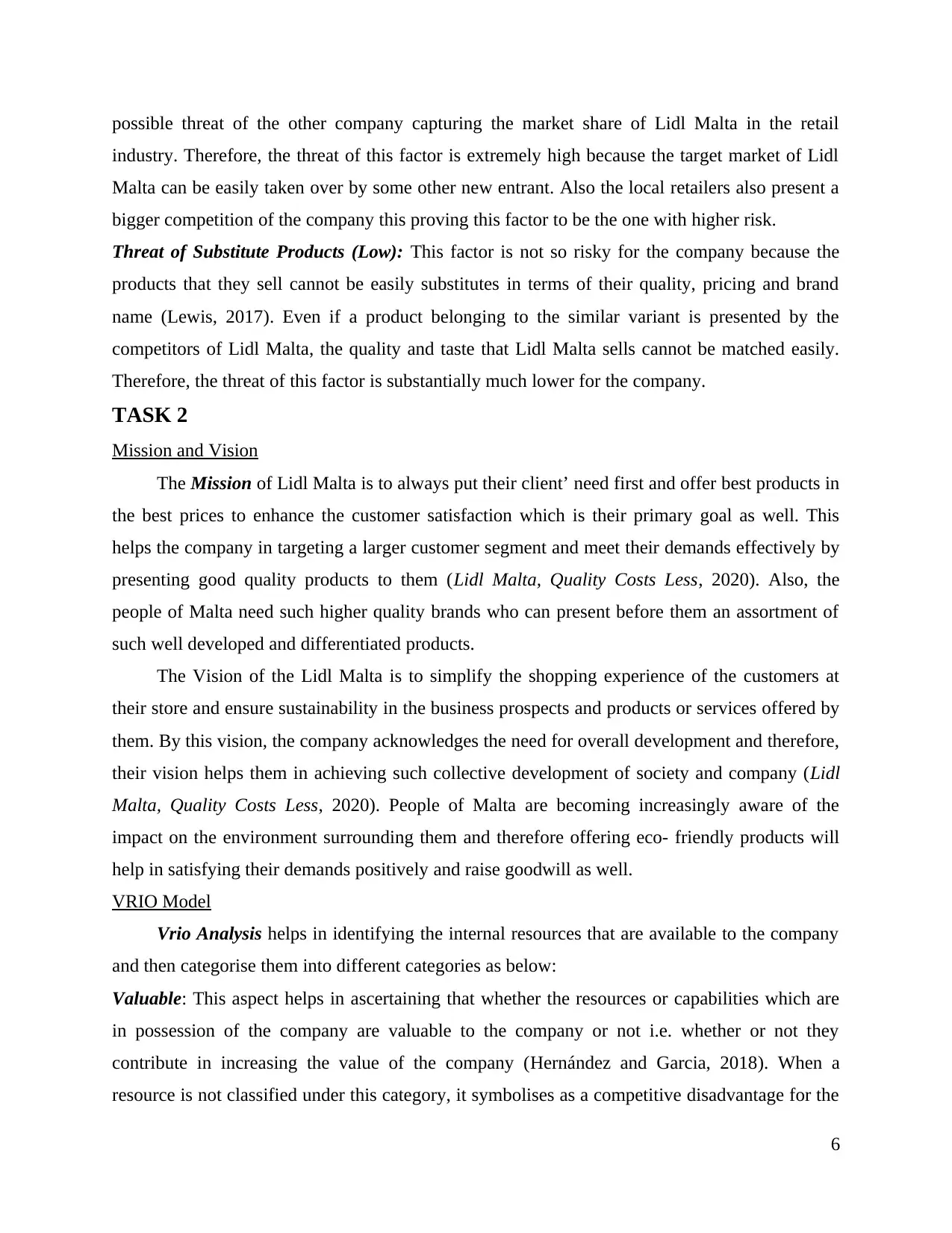
possible threat of the other company capturing the market share of Lidl Malta in the retail
industry. Therefore, the threat of this factor is extremely high because the target market of Lidl
Malta can be easily taken over by some other new entrant. Also the local retailers also present a
bigger competition of the company this proving this factor to be the one with higher risk.
Threat of Substitute Products (Low): This factor is not so risky for the company because the
products that they sell cannot be easily substitutes in terms of their quality, pricing and brand
name (Lewis, 2017). Even if a product belonging to the similar variant is presented by the
competitors of Lidl Malta, the quality and taste that Lidl Malta sells cannot be matched easily.
Therefore, the threat of this factor is substantially much lower for the company.
TASK 2
Mission and Vision
The Mission of Lidl Malta is to always put their client’ need first and offer best products in
the best prices to enhance the customer satisfaction which is their primary goal as well. This
helps the company in targeting a larger customer segment and meet their demands effectively by
presenting good quality products to them (Lidl Malta, Quality Costs Less, 2020). Also, the
people of Malta need such higher quality brands who can present before them an assortment of
such well developed and differentiated products.
The Vision of the Lidl Malta is to simplify the shopping experience of the customers at
their store and ensure sustainability in the business prospects and products or services offered by
them. By this vision, the company acknowledges the need for overall development and therefore,
their vision helps them in achieving such collective development of society and company (Lidl
Malta, Quality Costs Less, 2020). People of Malta are becoming increasingly aware of the
impact on the environment surrounding them and therefore offering eco- friendly products will
help in satisfying their demands positively and raise goodwill as well.
VRIO Model
Vrio Analysis helps in identifying the internal resources that are available to the company
and then categorise them into different categories as below:
Valuable: This aspect helps in ascertaining that whether the resources or capabilities which are
in possession of the company are valuable to the company or not i.e. whether or not they
contribute in increasing the value of the company (Hernández and Garcia, 2018). When a
resource is not classified under this category, it symbolises as a competitive disadvantage for the
6
industry. Therefore, the threat of this factor is extremely high because the target market of Lidl
Malta can be easily taken over by some other new entrant. Also the local retailers also present a
bigger competition of the company this proving this factor to be the one with higher risk.
Threat of Substitute Products (Low): This factor is not so risky for the company because the
products that they sell cannot be easily substitutes in terms of their quality, pricing and brand
name (Lewis, 2017). Even if a product belonging to the similar variant is presented by the
competitors of Lidl Malta, the quality and taste that Lidl Malta sells cannot be matched easily.
Therefore, the threat of this factor is substantially much lower for the company.
TASK 2
Mission and Vision
The Mission of Lidl Malta is to always put their client’ need first and offer best products in
the best prices to enhance the customer satisfaction which is their primary goal as well. This
helps the company in targeting a larger customer segment and meet their demands effectively by
presenting good quality products to them (Lidl Malta, Quality Costs Less, 2020). Also, the
people of Malta need such higher quality brands who can present before them an assortment of
such well developed and differentiated products.
The Vision of the Lidl Malta is to simplify the shopping experience of the customers at
their store and ensure sustainability in the business prospects and products or services offered by
them. By this vision, the company acknowledges the need for overall development and therefore,
their vision helps them in achieving such collective development of society and company (Lidl
Malta, Quality Costs Less, 2020). People of Malta are becoming increasingly aware of the
impact on the environment surrounding them and therefore offering eco- friendly products will
help in satisfying their demands positively and raise goodwill as well.
VRIO Model
Vrio Analysis helps in identifying the internal resources that are available to the company
and then categorise them into different categories as below:
Valuable: This aspect helps in ascertaining that whether the resources or capabilities which are
in possession of the company are valuable to the company or not i.e. whether or not they
contribute in increasing the value of the company (Hernández and Garcia, 2018). When a
resource is not classified under this category, it symbolises as a competitive disadvantage for the
6
⊘ This is a preview!⊘
Do you want full access?
Subscribe today to unlock all pages.

Trusted by 1+ million students worldwide
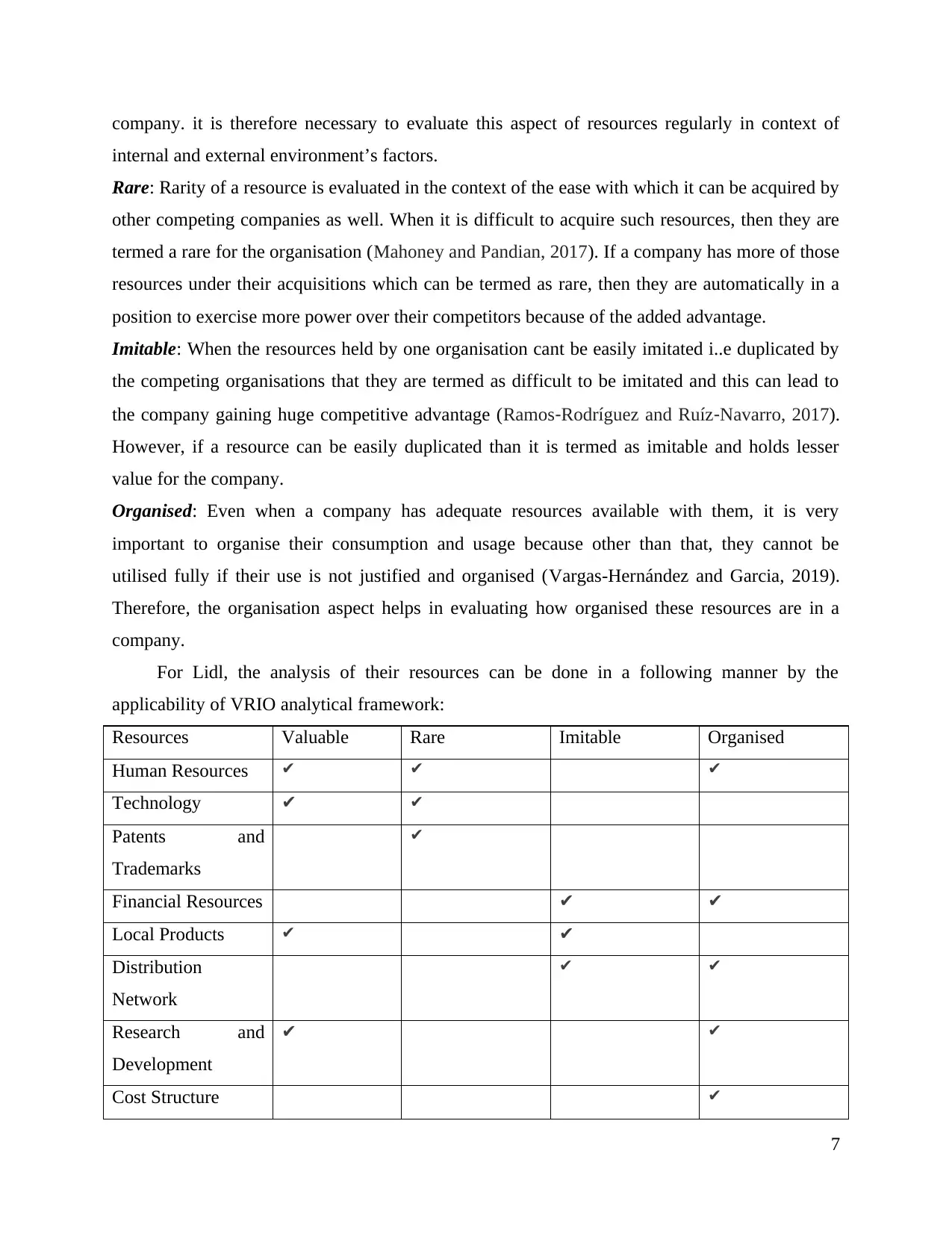
company. it is therefore necessary to evaluate this aspect of resources regularly in context of
internal and external environment’s factors.
Rare: Rarity of a resource is evaluated in the context of the ease with which it can be acquired by
other competing companies as well. When it is difficult to acquire such resources, then they are
termed a rare for the organisation (Mahoney and Pandian, 2017). If a company has more of those
resources under their acquisitions which can be termed as rare, then they are automatically in a
position to exercise more power over their competitors because of the added advantage.
Imitable: When the resources held by one organisation cant be easily imitated i..e duplicated by
the competing organisations that they are termed as difficult to be imitated and this can lead to
the company gaining huge competitive advantage (Ramos‐Rodríguez and Ruíz‐Navarro, 2017).
However, if a resource can be easily duplicated than it is termed as imitable and holds lesser
value for the company.
Organised: Even when a company has adequate resources available with them, it is very
important to organise their consumption and usage because other than that, they cannot be
utilised fully if their use is not justified and organised (Vargas-Hernández and Garcia, 2019).
Therefore, the organisation aspect helps in evaluating how organised these resources are in a
company.
For Lidl, the analysis of their resources can be done in a following manner by the
applicability of VRIO analytical framework:
Resources Valuable Rare Imitable Organised
Human Resources ✔ ✔ ✔
Technology ✔ ✔
Patents and
Trademarks
✔
Financial Resources ✔ ✔
Local Products ✔ ✔
Distribution
Network
✔ ✔
Research and
Development
✔ ✔
Cost Structure ✔
7
internal and external environment’s factors.
Rare: Rarity of a resource is evaluated in the context of the ease with which it can be acquired by
other competing companies as well. When it is difficult to acquire such resources, then they are
termed a rare for the organisation (Mahoney and Pandian, 2017). If a company has more of those
resources under their acquisitions which can be termed as rare, then they are automatically in a
position to exercise more power over their competitors because of the added advantage.
Imitable: When the resources held by one organisation cant be easily imitated i..e duplicated by
the competing organisations that they are termed as difficult to be imitated and this can lead to
the company gaining huge competitive advantage (Ramos‐Rodríguez and Ruíz‐Navarro, 2017).
However, if a resource can be easily duplicated than it is termed as imitable and holds lesser
value for the company.
Organised: Even when a company has adequate resources available with them, it is very
important to organise their consumption and usage because other than that, they cannot be
utilised fully if their use is not justified and organised (Vargas-Hernández and Garcia, 2019).
Therefore, the organisation aspect helps in evaluating how organised these resources are in a
company.
For Lidl, the analysis of their resources can be done in a following manner by the
applicability of VRIO analytical framework:
Resources Valuable Rare Imitable Organised
Human Resources ✔ ✔ ✔
Technology ✔ ✔
Patents and
Trademarks
✔
Financial Resources ✔ ✔
Local Products ✔ ✔
Distribution
Network
✔ ✔
Research and
Development
✔ ✔
Cost Structure ✔
7
Paraphrase This Document
Need a fresh take? Get an instant paraphrase of this document with our AI Paraphraser
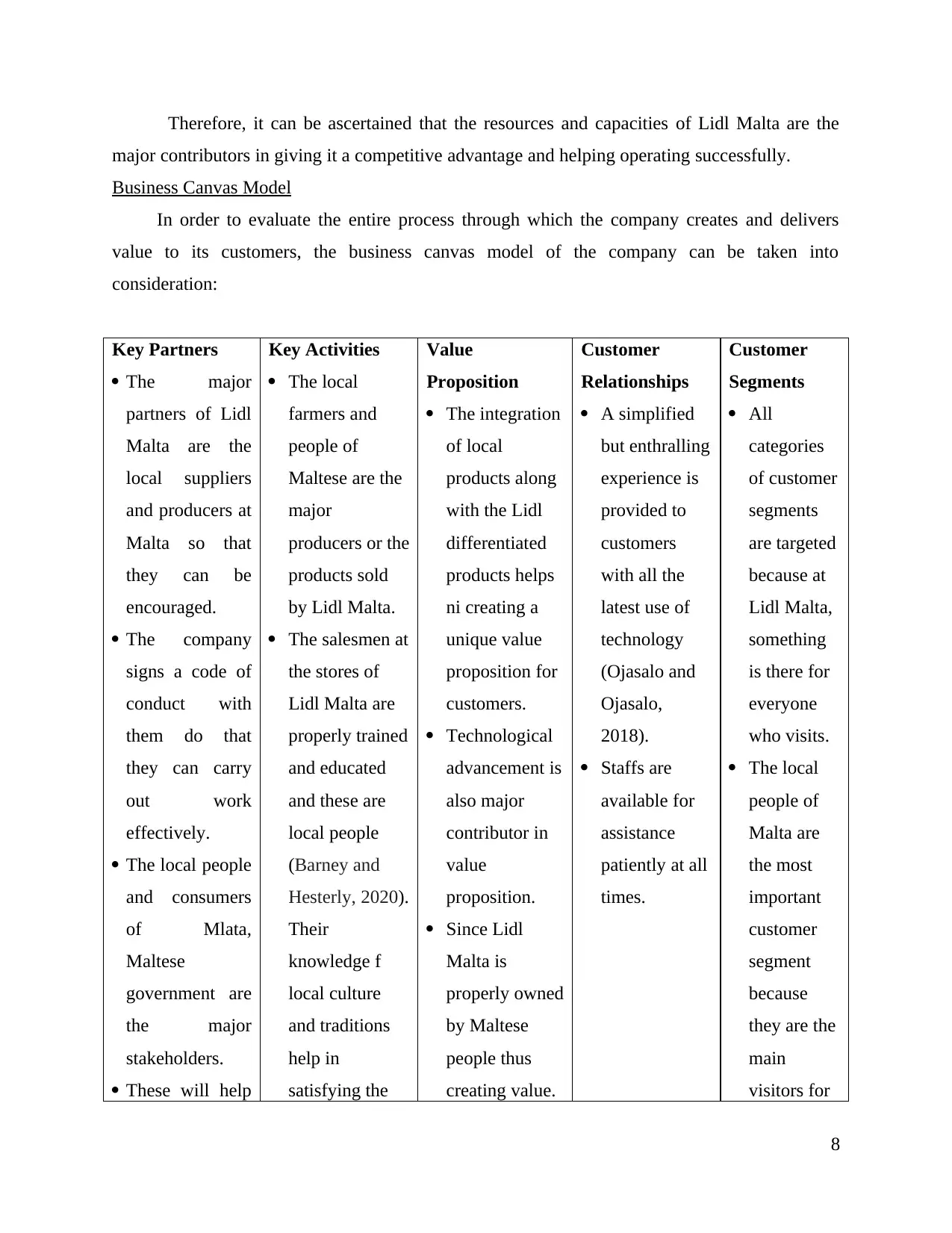
Therefore, it can be ascertained that the resources and capacities of Lidl Malta are the
major contributors in giving it a competitive advantage and helping operating successfully.
Business Canvas Model
In order to evaluate the entire process through which the company creates and delivers
value to its customers, the business canvas model of the company can be taken into
consideration:
Key Partners
The major
partners of Lidl
Malta are the
local suppliers
and producers at
Malta so that
they can be
encouraged.
The company
signs a code of
conduct with
them do that
they can carry
out work
effectively.
The local people
and consumers
of Mlata,
Maltese
government are
the major
stakeholders.
These will help
Key Activities
The local
farmers and
people of
Maltese are the
major
producers or the
products sold
by Lidl Malta.
The salesmen at
the stores of
Lidl Malta are
properly trained
and educated
and these are
local people
(Barney and
Hesterly, 2020).
Their
knowledge f
local culture
and traditions
help in
satisfying the
Value
Proposition
The integration
of local
products along
with the Lidl
differentiated
products helps
ni creating a
unique value
proposition for
customers.
Technological
advancement is
also major
contributor in
value
proposition.
Since Lidl
Malta is
properly owned
by Maltese
people thus
creating value.
Customer
Relationships
A simplified
but enthralling
experience is
provided to
customers
with all the
latest use of
technology
(Ojasalo and
Ojasalo,
2018).
Staffs are
available for
assistance
patiently at all
times.
Customer
Segments
All
categories
of customer
segments
are targeted
because at
Lidl Malta,
something
is there for
everyone
who visits.
The local
people of
Malta are
the most
important
customer
segment
because
they are the
main
visitors for
8
major contributors in giving it a competitive advantage and helping operating successfully.
Business Canvas Model
In order to evaluate the entire process through which the company creates and delivers
value to its customers, the business canvas model of the company can be taken into
consideration:
Key Partners
The major
partners of Lidl
Malta are the
local suppliers
and producers at
Malta so that
they can be
encouraged.
The company
signs a code of
conduct with
them do that
they can carry
out work
effectively.
The local people
and consumers
of Mlata,
Maltese
government are
the major
stakeholders.
These will help
Key Activities
The local
farmers and
people of
Maltese are the
major
producers or the
products sold
by Lidl Malta.
The salesmen at
the stores of
Lidl Malta are
properly trained
and educated
and these are
local people
(Barney and
Hesterly, 2020).
Their
knowledge f
local culture
and traditions
help in
satisfying the
Value
Proposition
The integration
of local
products along
with the Lidl
differentiated
products helps
ni creating a
unique value
proposition for
customers.
Technological
advancement is
also major
contributor in
value
proposition.
Since Lidl
Malta is
properly owned
by Maltese
people thus
creating value.
Customer
Relationships
A simplified
but enthralling
experience is
provided to
customers
with all the
latest use of
technology
(Ojasalo and
Ojasalo,
2018).
Staffs are
available for
assistance
patiently at all
times.
Customer
Segments
All
categories
of customer
segments
are targeted
because at
Lidl Malta,
something
is there for
everyone
who visits.
The local
people of
Malta are
the most
important
customer
segment
because
they are the
main
visitors for
8
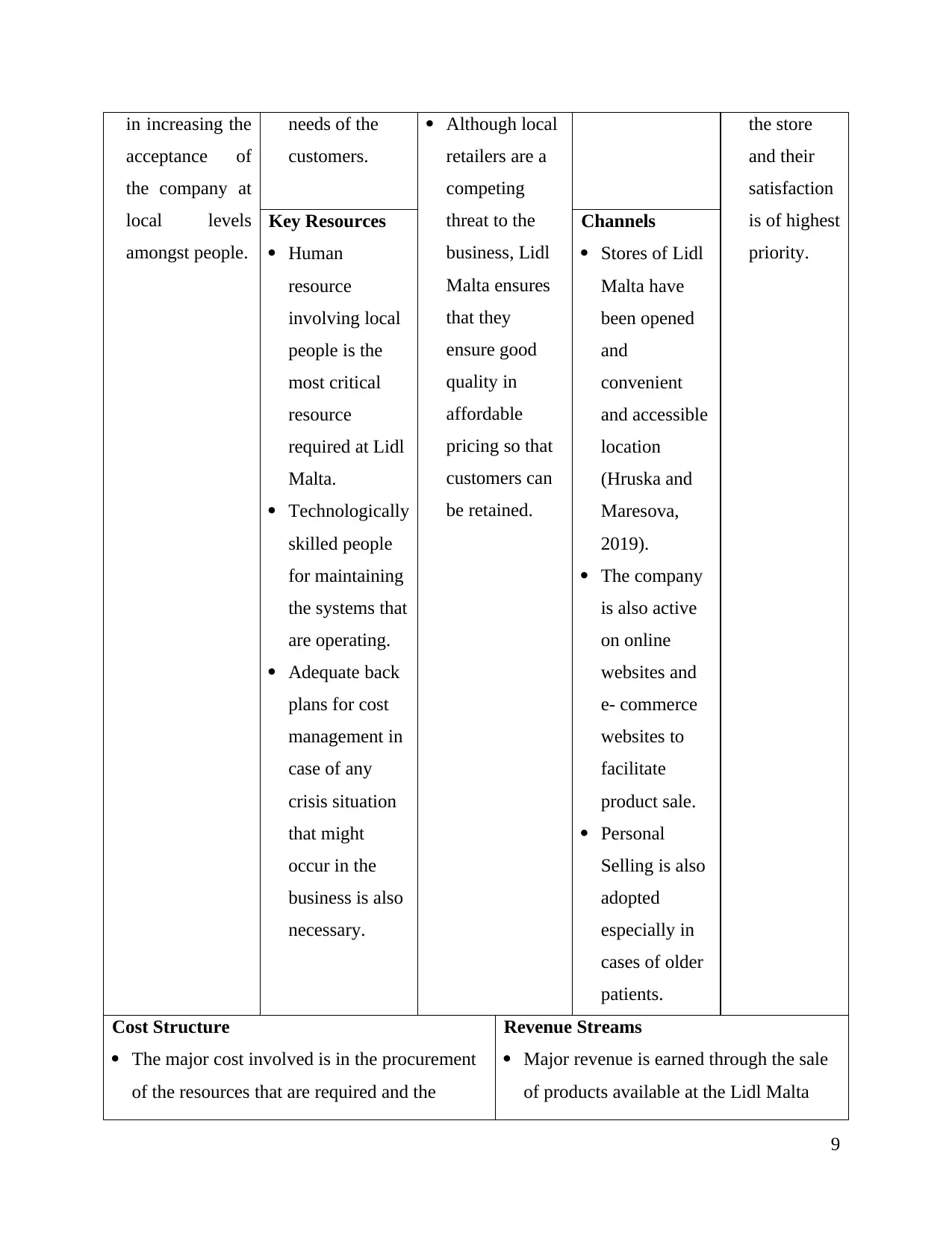
in increasing the
acceptance of
the company at
local levels
amongst people.
needs of the
customers.
Although local
retailers are a
competing
threat to the
business, Lidl
Malta ensures
that they
ensure good
quality in
affordable
pricing so that
customers can
be retained.
the store
and their
satisfaction
is of highest
priority.
Key Resources
Human
resource
involving local
people is the
most critical
resource
required at Lidl
Malta.
Technologically
skilled people
for maintaining
the systems that
are operating.
Adequate back
plans for cost
management in
case of any
crisis situation
that might
occur in the
business is also
necessary.
Channels
Stores of Lidl
Malta have
been opened
and
convenient
and accessible
location
(Hruska and
Maresova,
2019).
The company
is also active
on online
websites and
e- commerce
websites to
facilitate
product sale.
Personal
Selling is also
adopted
especially in
cases of older
patients.
Cost Structure
The major cost involved is in the procurement
of the resources that are required and the
Revenue Streams
Major revenue is earned through the sale
of products available at the Lidl Malta
9
acceptance of
the company at
local levels
amongst people.
needs of the
customers.
Although local
retailers are a
competing
threat to the
business, Lidl
Malta ensures
that they
ensure good
quality in
affordable
pricing so that
customers can
be retained.
the store
and their
satisfaction
is of highest
priority.
Key Resources
Human
resource
involving local
people is the
most critical
resource
required at Lidl
Malta.
Technologically
skilled people
for maintaining
the systems that
are operating.
Adequate back
plans for cost
management in
case of any
crisis situation
that might
occur in the
business is also
necessary.
Channels
Stores of Lidl
Malta have
been opened
and
convenient
and accessible
location
(Hruska and
Maresova,
2019).
The company
is also active
on online
websites and
e- commerce
websites to
facilitate
product sale.
Personal
Selling is also
adopted
especially in
cases of older
patients.
Cost Structure
The major cost involved is in the procurement
of the resources that are required and the
Revenue Streams
Major revenue is earned through the sale
of products available at the Lidl Malta
9
⊘ This is a preview!⊘
Do you want full access?
Subscribe today to unlock all pages.

Trusted by 1+ million students worldwide
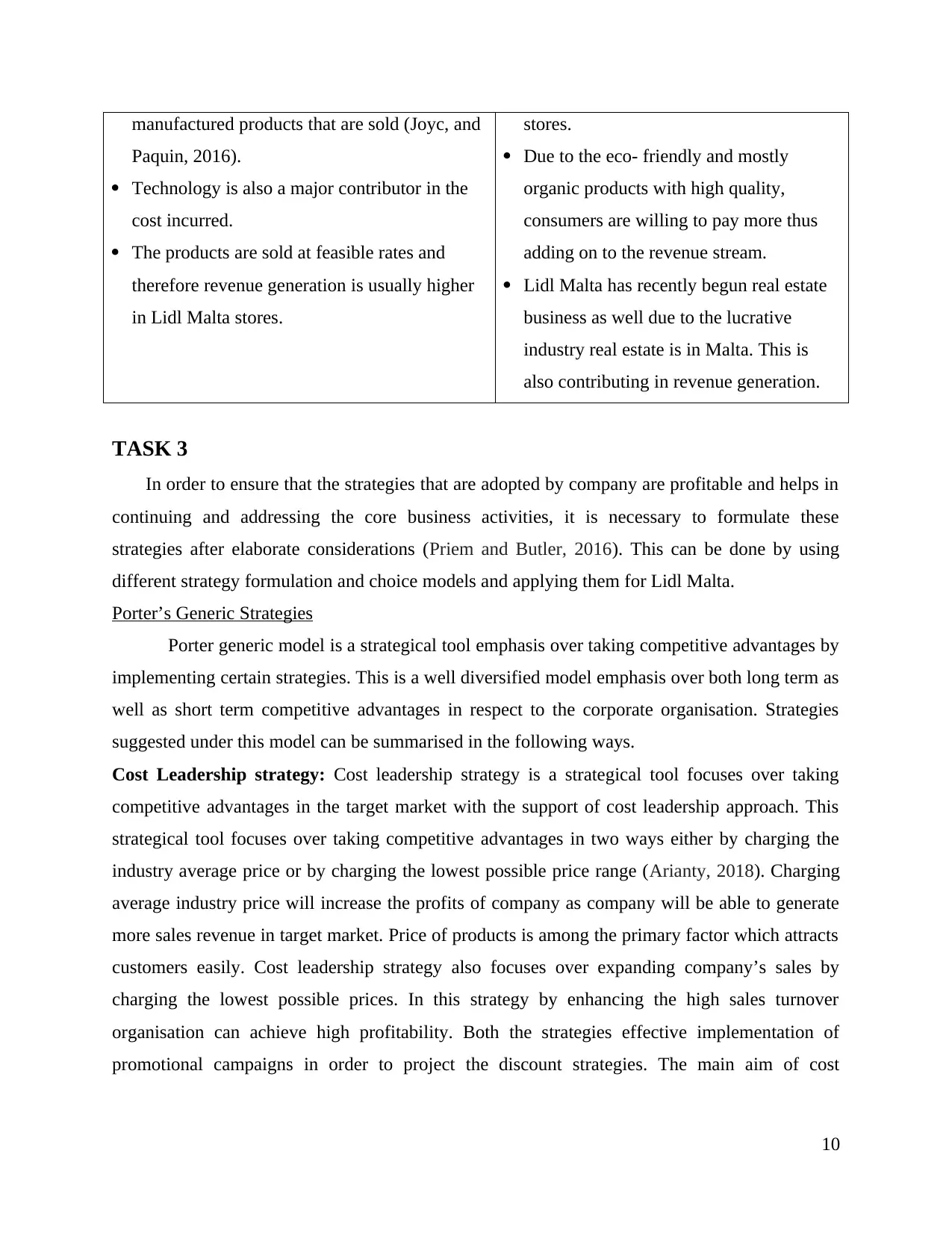
manufactured products that are sold (Joyc, and
Paquin, 2016).
Technology is also a major contributor in the
cost incurred.
The products are sold at feasible rates and
therefore revenue generation is usually higher
in Lidl Malta stores.
stores.
Due to the eco- friendly and mostly
organic products with high quality,
consumers are willing to pay more thus
adding on to the revenue stream.
Lidl Malta has recently begun real estate
business as well due to the lucrative
industry real estate is in Malta. This is
also contributing in revenue generation.
TASK 3
In order to ensure that the strategies that are adopted by company are profitable and helps in
continuing and addressing the core business activities, it is necessary to formulate these
strategies after elaborate considerations (Priem and Butler, 2016). This can be done by using
different strategy formulation and choice models and applying them for Lidl Malta.
Porter’s Generic Strategies
Porter generic model is a strategical tool emphasis over taking competitive advantages by
implementing certain strategies. This is a well diversified model emphasis over both long term as
well as short term competitive advantages in respect to the corporate organisation. Strategies
suggested under this model can be summarised in the following ways.
Cost Leadership strategy: Cost leadership strategy is a strategical tool focuses over taking
competitive advantages in the target market with the support of cost leadership approach. This
strategical tool focuses over taking competitive advantages in two ways either by charging the
industry average price or by charging the lowest possible price range (Arianty, 2018). Charging
average industry price will increase the profits of company as company will be able to generate
more sales revenue in target market. Price of products is among the primary factor which attracts
customers easily. Cost leadership strategy also focuses over expanding company’s sales by
charging the lowest possible prices. In this strategy by enhancing the high sales turnover
organisation can achieve high profitability. Both the strategies effective implementation of
promotional campaigns in order to project the discount strategies. The main aim of cost
10
Paquin, 2016).
Technology is also a major contributor in the
cost incurred.
The products are sold at feasible rates and
therefore revenue generation is usually higher
in Lidl Malta stores.
stores.
Due to the eco- friendly and mostly
organic products with high quality,
consumers are willing to pay more thus
adding on to the revenue stream.
Lidl Malta has recently begun real estate
business as well due to the lucrative
industry real estate is in Malta. This is
also contributing in revenue generation.
TASK 3
In order to ensure that the strategies that are adopted by company are profitable and helps in
continuing and addressing the core business activities, it is necessary to formulate these
strategies after elaborate considerations (Priem and Butler, 2016). This can be done by using
different strategy formulation and choice models and applying them for Lidl Malta.
Porter’s Generic Strategies
Porter generic model is a strategical tool emphasis over taking competitive advantages by
implementing certain strategies. This is a well diversified model emphasis over both long term as
well as short term competitive advantages in respect to the corporate organisation. Strategies
suggested under this model can be summarised in the following ways.
Cost Leadership strategy: Cost leadership strategy is a strategical tool focuses over taking
competitive advantages in the target market with the support of cost leadership approach. This
strategical tool focuses over taking competitive advantages in two ways either by charging the
industry average price or by charging the lowest possible price range (Arianty, 2018). Charging
average industry price will increase the profits of company as company will be able to generate
more sales revenue in target market. Price of products is among the primary factor which attracts
customers easily. Cost leadership strategy also focuses over expanding company’s sales by
charging the lowest possible prices. In this strategy by enhancing the high sales turnover
organisation can achieve high profitability. Both the strategies effective implementation of
promotional campaigns in order to project the discount strategies. The main aim of cost
10
Paraphrase This Document
Need a fresh take? Get an instant paraphrase of this document with our AI Paraphraser
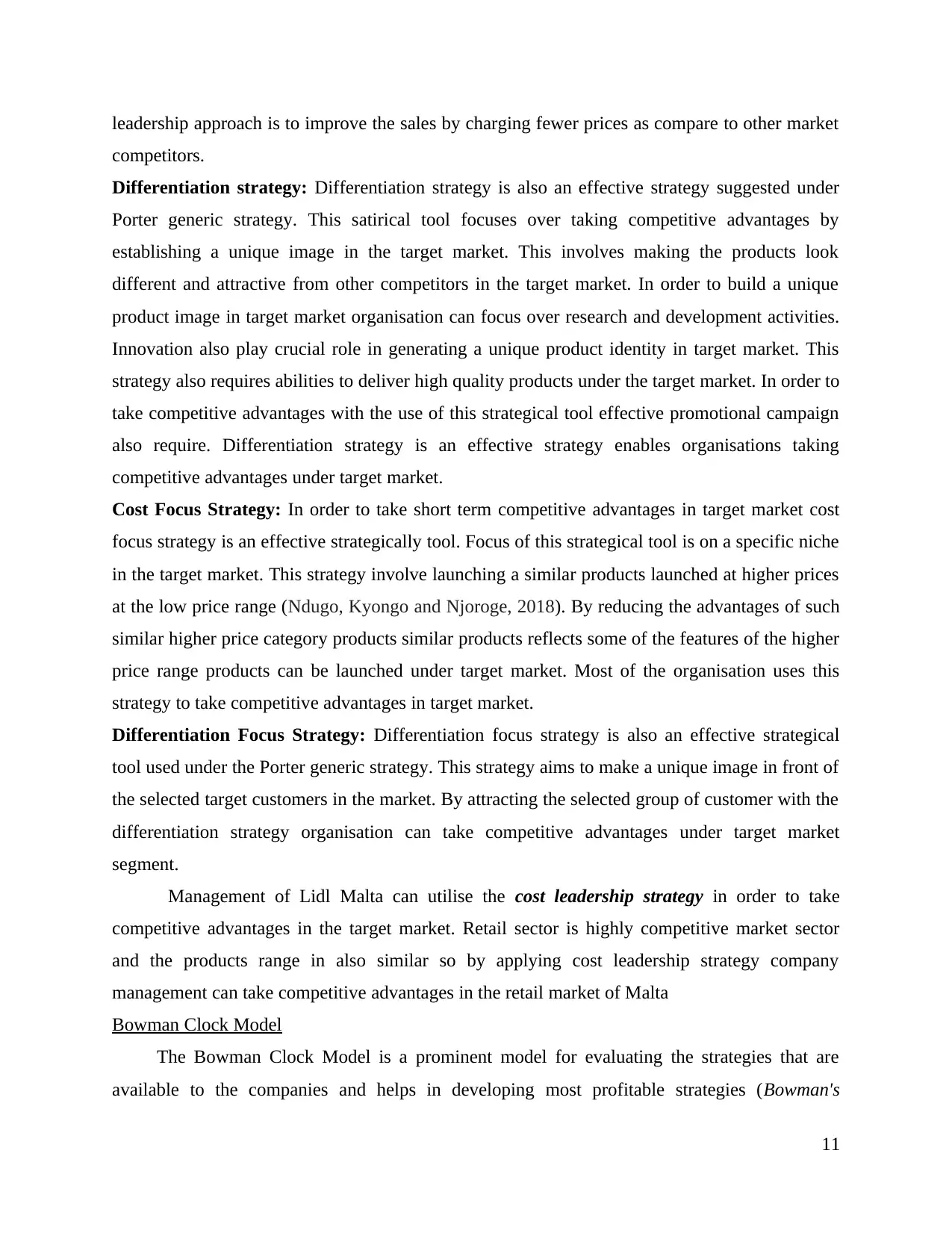
leadership approach is to improve the sales by charging fewer prices as compare to other market
competitors.
Differentiation strategy: Differentiation strategy is also an effective strategy suggested under
Porter generic strategy. This satirical tool focuses over taking competitive advantages by
establishing a unique image in the target market. This involves making the products look
different and attractive from other competitors in the target market. In order to build a unique
product image in target market organisation can focus over research and development activities.
Innovation also play crucial role in generating a unique product identity in target market. This
strategy also requires abilities to deliver high quality products under the target market. In order to
take competitive advantages with the use of this strategical tool effective promotional campaign
also require. Differentiation strategy is an effective strategy enables organisations taking
competitive advantages under target market.
Cost Focus Strategy: In order to take short term competitive advantages in target market cost
focus strategy is an effective strategically tool. Focus of this strategical tool is on a specific niche
in the target market. This strategy involve launching a similar products launched at higher prices
at the low price range (Ndugo, Kyongo and Njoroge, 2018). By reducing the advantages of such
similar higher price category products similar products reflects some of the features of the higher
price range products can be launched under target market. Most of the organisation uses this
strategy to take competitive advantages in target market.
Differentiation Focus Strategy: Differentiation focus strategy is also an effective strategical
tool used under the Porter generic strategy. This strategy aims to make a unique image in front of
the selected target customers in the market. By attracting the selected group of customer with the
differentiation strategy organisation can take competitive advantages under target market
segment.
Management of Lidl Malta can utilise the cost leadership strategy in order to take
competitive advantages in the target market. Retail sector is highly competitive market sector
and the products range in also similar so by applying cost leadership strategy company
management can take competitive advantages in the retail market of Malta
Bowman Clock Model
The Bowman Clock Model is a prominent model for evaluating the strategies that are
available to the companies and helps in developing most profitable strategies (Bowman's
11
competitors.
Differentiation strategy: Differentiation strategy is also an effective strategy suggested under
Porter generic strategy. This satirical tool focuses over taking competitive advantages by
establishing a unique image in the target market. This involves making the products look
different and attractive from other competitors in the target market. In order to build a unique
product image in target market organisation can focus over research and development activities.
Innovation also play crucial role in generating a unique product identity in target market. This
strategy also requires abilities to deliver high quality products under the target market. In order to
take competitive advantages with the use of this strategical tool effective promotional campaign
also require. Differentiation strategy is an effective strategy enables organisations taking
competitive advantages under target market.
Cost Focus Strategy: In order to take short term competitive advantages in target market cost
focus strategy is an effective strategically tool. Focus of this strategical tool is on a specific niche
in the target market. This strategy involve launching a similar products launched at higher prices
at the low price range (Ndugo, Kyongo and Njoroge, 2018). By reducing the advantages of such
similar higher price category products similar products reflects some of the features of the higher
price range products can be launched under target market. Most of the organisation uses this
strategy to take competitive advantages in target market.
Differentiation Focus Strategy: Differentiation focus strategy is also an effective strategical
tool used under the Porter generic strategy. This strategy aims to make a unique image in front of
the selected target customers in the market. By attracting the selected group of customer with the
differentiation strategy organisation can take competitive advantages under target market
segment.
Management of Lidl Malta can utilise the cost leadership strategy in order to take
competitive advantages in the target market. Retail sector is highly competitive market sector
and the products range in also similar so by applying cost leadership strategy company
management can take competitive advantages in the retail market of Malta
Bowman Clock Model
The Bowman Clock Model is a prominent model for evaluating the strategies that are
available to the companies and helps in developing most profitable strategies (Bowman's
11
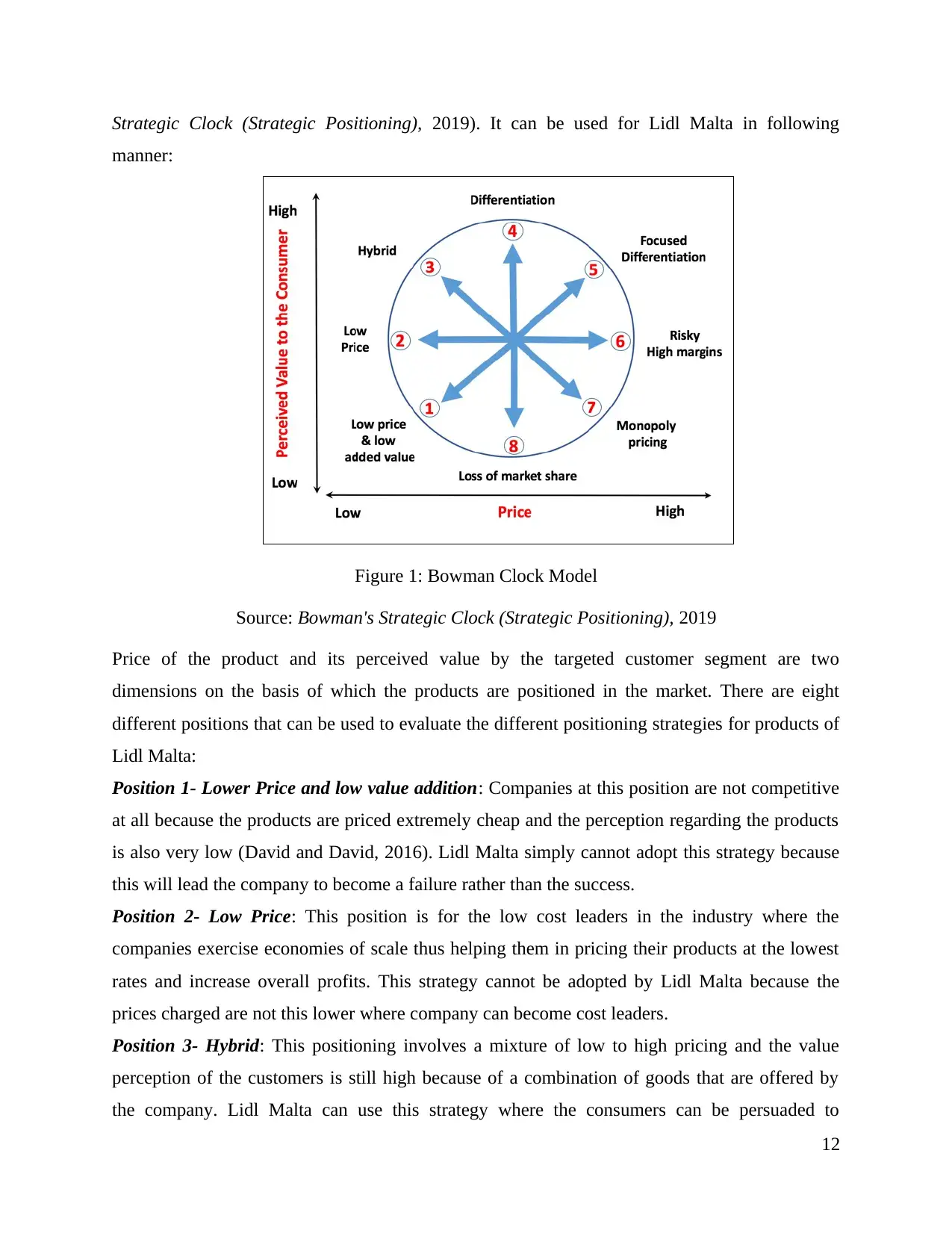
Strategic Clock (Strategic Positioning), 2019). It can be used for Lidl Malta in following
manner:
Figure 1: Bowman Clock Model
Source: Bowman's Strategic Clock (Strategic Positioning), 2019
Price of the product and its perceived value by the targeted customer segment are two
dimensions on the basis of which the products are positioned in the market. There are eight
different positions that can be used to evaluate the different positioning strategies for products of
Lidl Malta:
Position 1- Lower Price and low value addition: Companies at this position are not competitive
at all because the products are priced extremely cheap and the perception regarding the products
is also very low (David and David, 2016). Lidl Malta simply cannot adopt this strategy because
this will lead the company to become a failure rather than the success.
Position 2- Low Price: This position is for the low cost leaders in the industry where the
companies exercise economies of scale thus helping them in pricing their products at the lowest
rates and increase overall profits. This strategy cannot be adopted by Lidl Malta because the
prices charged are not this lower where company can become cost leaders.
Position 3- Hybrid: This positioning involves a mixture of low to high pricing and the value
perception of the customers is still high because of a combination of goods that are offered by
the company. Lidl Malta can use this strategy where the consumers can be persuaded to
12
manner:
Figure 1: Bowman Clock Model
Source: Bowman's Strategic Clock (Strategic Positioning), 2019
Price of the product and its perceived value by the targeted customer segment are two
dimensions on the basis of which the products are positioned in the market. There are eight
different positions that can be used to evaluate the different positioning strategies for products of
Lidl Malta:
Position 1- Lower Price and low value addition: Companies at this position are not competitive
at all because the products are priced extremely cheap and the perception regarding the products
is also very low (David and David, 2016). Lidl Malta simply cannot adopt this strategy because
this will lead the company to become a failure rather than the success.
Position 2- Low Price: This position is for the low cost leaders in the industry where the
companies exercise economies of scale thus helping them in pricing their products at the lowest
rates and increase overall profits. This strategy cannot be adopted by Lidl Malta because the
prices charged are not this lower where company can become cost leaders.
Position 3- Hybrid: This positioning involves a mixture of low to high pricing and the value
perception of the customers is still high because of a combination of goods that are offered by
the company. Lidl Malta can use this strategy where the consumers can be persuaded to
12
⊘ This is a preview!⊘
Do you want full access?
Subscribe today to unlock all pages.

Trusted by 1+ million students worldwide
1 out of 17
Related Documents
Your All-in-One AI-Powered Toolkit for Academic Success.
+13062052269
info@desklib.com
Available 24*7 on WhatsApp / Email
![[object Object]](/_next/static/media/star-bottom.7253800d.svg)
Unlock your academic potential
Copyright © 2020–2025 A2Z Services. All Rights Reserved. Developed and managed by ZUCOL.





